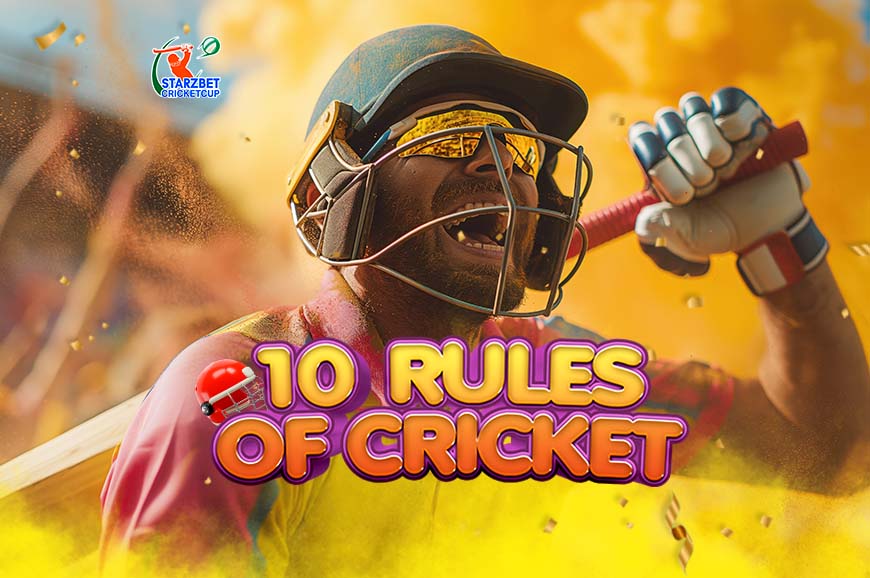Cricket, considered a gentleman’s game, has captured millions worldwide with its rich history and strategic intricacy. This article will help you understand the fundamentals, whether you’re new to the sport or a seasoned fan brushing up.
What are the 10 fundamental cricket rules that underpin this intriguing game? From run-scoring to dismissals, these 10 essential rules of cricket will help you comprehend the sport. Explore these essential cricket rules for fans.
List of 10 Important Rules of Cricket
- Leg Before Wicket (LBW)
- The No Ball Rule
- The Wide Ball Rule
- The Dead Ball Rule
- The Follow-On Rule
- Powerplay Rules
- The Super Over Rule
- Timed Out
- Appeals
- The Role of Umpires
10 Basic Rules of Cricket Explained
Before betting online, it is crucial to understand the 10 basic rules of cricket. The basic game in cricket is that two groups compete against each other. Each league has different overs, and each team will get a chance to bat and field. A coin toss will choose the turns.
1. Leg Before Wicket (LBW)
Leg Before Wicket (LBW) is a contentious cricket rule. If the ball hits a batsman’s leg or body and the umpire thinks it would have struck the stumps, they can pronounce them out LBW. The batter cannot be out LBW if the ball pitches outside the leg stump or if they try to strike it.
2. No Ball Rule
A no-ball rule is called when the bowler crosses the popping crease or bowls an unlawful delivery. After a no-ball, the batting side gets an extra run, and the next ball is a free hit, so the batsman can only be dismissed by run-out.
3. Wide Ball Rule
Wide balls are bowled outside the specified line, too far from the batsman to hit. Especially in limited-overs cricket, extras can change the outcome. Wide balls give the batting side an extra run and an extra delivery.
4. Dead Ball Rule
The play stops at a dead ball. The batter may need to be prepared, the ball may be misdelivered, or an external reason may disrupt play. No runs or dismissals are recorded when the umpire flags a dead ball.
5. Follow-On Rule
Mostly this rule is applicable during the test cricket matches. If the side batting first leads by 200 runs or more, they can ask the other team to bat immediately. This follow on rule is basically used to save time and get a immediate match result.
6. Powerplay Rules
Limited-overs powerplays matter. Fielding limits limit fielders outside the 30-yard circle during these stages. Powerplays often set the pace, encouraging aggressive batting. Powerplay regulations differ per format, affecting team strategies.
7. Super-Over Rule
Tied limited-over matches are decided by a super over. Teams bat for one over with two wickets. The team with the most runs wins. To break a deadlocked Super Over, the number of boundaries scored during the match is used.
8. Timeout
A batsman is timed out if they don’t take the crease within three minutes following the previous batsman’s dismissal. Timeout rules in cricket are rarely used; this dismissal enforces discipline and time management.
9. Appeals
Fielding teams must petition the umpire to dismiss a batsman. Most appeals are brought to the notice by saying, “How’s that?” or “Howzat?” Players should alert umpires to potential dismissals because they will only rule after an appeal. Decision Review System (DRS) reviews have been added to this regulation.
10. Role of the Umpire
Cricket umpires ensure fair play. Their decisions on dismissals, limits, and other game aspects are crucial. Modern cricket uses technology to help umpires, but their judgment is crucial. Beyond rulings, they control on-field behaviour and game flow.
Why Knowing Cricket Rules is So Important?
Learning the 10 basic rules of cricket will improve your game and promote fairness and respect for the sport. Every cricketer should know the rules for these reasons:
- Avoid Penalties: Misinterpreting rules might cost you runs or wickets. Know the rules to avoid blunders.
- Enhance Teamwork: Teamwork and strategy enhance when everyone knows the rules.
- Increase Confidence: Knowing the regulations helps you focus on your performance during the game.
Other Important Cricket Rules and Regulations
The preceding 10 basic rules of cricket cover most of what you need to know, but players should also remember these:
- Fair and Unfair Play: Cricket has strict fair play rules. Unfair practices like tampering with the ball or impeding a fielder can result in penalties.
- Fielding Restrictions: In limited-overs cricket, precise rules limit where fielders can stand. This ensures a balance between the bat and ball, making it tougher for the fielding team to crowd the boundary excessively.
- Injury and Substitutes: The team can swap a fielder for an injured player, but they cannot bowl or bat. A new rule enables concussion substitutes in some instances.
Conclusion
Understanding the 10 basic rules of cricket and the game regulations can not only help you become a better player but also boost your general love of the game. Each of these 15 rules plays a crucial part in how the game is played, ensuring fairness and retaining the competitive spirit of cricket.
If you’re enthusiastic about cricket, you can explore our CricketCup blogs to learn various interesting facts about this game and online cricket betting. You may also increase your skills by checking out additional cricket online betting tips.
FAQ
Two 11-player teams score runs by hitting the ball and dismissing the other team’s batters through bowling, catching, and run-outs.
If the ball hits a batsman’s leg in line with the stumps and would have hit the stumps, he is dismissed for LBW.
The number of overs varies on the format. There are no over limits in Test cricket, although ODIs have 50 and T20s have 20.
In limited-overs cricket, fielding limits give batsmen extra chances to score in the powerplay.
No, substitutes can only field. Injured players can now bat or bowl as concussion substitutes.
->God Of Cricket In IPL 2024
->Astrology Cricket Betting Tips
->GHD Sports Free Live Cricket Everywhere






2 Replies to “10 Rules of Cricket You Need to Know”
[…] proper licensing agreements, which could pose legal dangers. Users must know their local laws and rules regarding streaming content […]
[…] Cricket Council (ICC) provides straightforward tips on handling suspended matches. These guidelines cover the reasons for suspension, methods of observation, and criteria for resuming […]